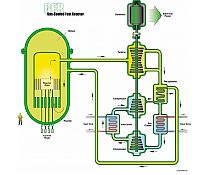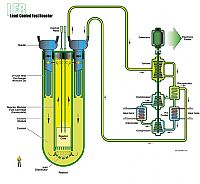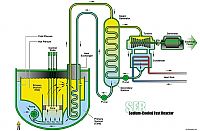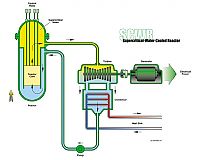|
GFR – Gas-Cooled Fast Reactor System
|

|


|

|
GFR – Gas-Cooled Fast Reactor System
The GFR system features a fast-neutron-spectrum helium-cooled reactor and closed fuel cycle. Like thermal-spectrum helium-cooled reactors, the high outlet temperature of the helium coolant makes it possible to deliver electricity, hydrogen, or process heat with high efficiency. The reference reactor is a 288-MWe helium-cooled system operating with an outlet temperature of 850°C using a direct Brayton cycle gas turbine for high thermal efficiency. Several fuel forms are candidates that hold the potential to operate at very high temperatures and to ensure an excellent retention of fission products: composite ceramic fuel, advanced fuel particles, or ceramic clad elements of actinide compounds. Core configurations may be based on prismatic blocks, pin- or plate-based fuel assemblies. The GFR reference has an integrated, on-site spent fuel treatment and refabrication plant.
The GFR uses a direct-cycle helium turbine for electricity generation, or can optionally use its process heat for thermochemical production of hydrogen. Through the combination of a fast spectrum and full recycle of actinides, the GFR minimizes the production of long-lived radioactive waste. The GFR’s fast spectrum also makes it possible to utilize available fissile and fertile materials (including depleted uranium) considerably more efficiently than thermal spectrum gas reactors with once-through fuel cycles.
1 files, last one added on Jul 19, 2006
Album viewed 298 times
|
|
|
LFR – Lead-Cooled Fast Reactor System
|

|


|

|
LFR – Lead-Cooled Fast Reactor System
The LFR system features a fast-spectrum lead or lead/bismuth eutectic liquid metal-cooled reactor and a closed fuel cycle for efficient conversion of fertile uranium and management of actinides. The system has a full actinide recycle fuel cycle with central or regional fuel cycle facilities. Options include a range of plant ratings, including a battery of 50-150 MWe [shown below] that features a very long refueling interval, a modular system rated at 300-400 MWe, and a large monolithic plant option at 1200 MWe. The term battery refers to the long-life, factory fabricated core, not to any provision for electrochemical energy conversion. The fuel is metal or nitride-based, containing fertile uranium and transuranics. The LFR is cooled by natural convection with a reactor outlet coolant temperature of 550°C, possibly ranging up to 800°C with advanced materials. The higher temperature enables the production of hydrogen by thermochemical processes.
The LFR battery is a small factory-built turnkey plant operating on a closed fuel cycle with very long refueling interval (15 to 20 years) cassette core or replaceable reactor module. Its features are designed to meet market opportunities for electricity production on small grids, and for developing countries that may not wish to deploy an indigenous fuel cycle infrastructure to support their nuclear energy systems. The battery system is designed for distributed generation of electricity and other energy products, including hydrogen and potable water.
1 files, last one added on Jul 19, 2006
Album viewed 253 times
|
|
|
|
SFR – Sodium-Cooled Fast Reactor System
|

|


|

|
SFR – Sodium-Cooled Fast Reactor System
The SFR system features a fast-spectrum sodium-cooled reactor and a closed fuel cycle for efficient management of actinides and conversion of fertile uranium. The fuel cycle employs full actinide recycle with two major options: One is an intermediate size (150 to 500 MWe) sodium-cooled reactor with a uranium-plutonium-minor-actinide-zirconium metal alloy fuel, supported by a fuel cycle based on pyrometallurgical processing in facilities integrated with the reactor. The second is a medium to large (500 to 1500 MWe) sodium-cooled reactor with mixed uranium-plutonium oxide fuel, supported by a fuel cycle based upon advanced aqueous processing at a central location serving a number of reactors. The outlet temperature is approximately 550°C for both.
The SFR is designed for management of high-level wastes and, in particular, management of plutonium and other actinides. Important safety features of the system include a long thermal response time, a large margin to coolant boiling, a primary system that operates near atmospheric pressure, and an intermediate sodium system between the radioactive sodium in the primary system and the water and steam in the power plant. With innovations to reduce capital cost, the SFR can serve markets for electricity. The SFR’s fast spectrum also makes it possible to utilize available fissile and fertile materials (including depleted uranium) considerably more efficiently than thermal spectrum reactors with once-through fuel cycles.
1 files, last one added on Jul 19, 2006
Album viewed 250 times
|
|
|
SCWR – Supercritical-Water-Cooled Reactor System
|

|


|

|
SCWR – Supercritical-Water-Cooled Reactor System
The SCWR system is a high-temperature, high-pressure water-cooled reactor that operates above the thermodynamic critical point of water (374°C, 22.1 MPa or 705°F, 3208 psia). The supercritical water coolant enables a thermal efficiency about one-third higher than current light water reactors, as well as simplifications in the balance of plant. The balance of plant is considerably simplified because the coolant does not change phase in the reactor and is directly coupled to the energy conversion equipment. The reference system is 1700 MWe with an operating pressure of 25 MPa, and a reactor outlet temperature of 510°C, possibly ranging up to 550°C. The fuel is uranium oxide. Passive safety features are incorporated similar to those of simplified boiling water reactors.
The SCWR system is primarily designed for efficient electricity production, with an option for actinide management based on two options in the core design: the SCWR may have a thermal or fast-spectrum. Thus, the system offers two fuel cycle options: the first is an open cycle with a thermal-spectrum reactor; the second is a closed cycle with a fast- spectrum reactor and full actinide recycle based on advanced aqueous processing at a central location.
1 files, last one added on Jul 19, 2006
Album viewed 263 times
|
|
|
|
|
|
|
